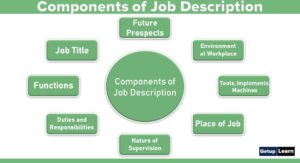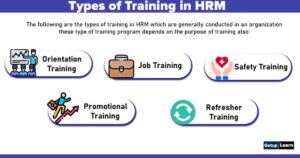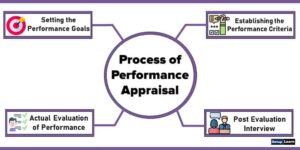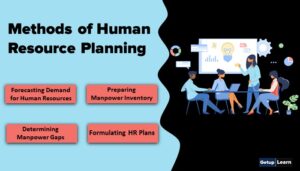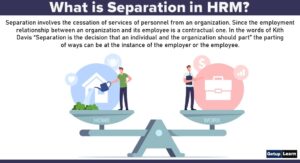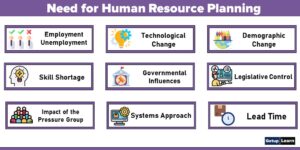
Table of Contents
-
1 Uses of Job Analysis Information in HRM
- 1.1 Human Resource Planning
- 1.2 Job Evaluation
- 1.3 Recruitment, Selection and Placement
- 1.4 Optimum Use of Human Resource
- 1.5 Training and Development
- 1.6 Labour Management Relations
- 1.7 Job Design
- 1.8 Safety and Welfare Measures
- 1.9 Compensation
- 1.10 Reduce Frustration
- 1.11 Determines Authority Responsibility Relationship
- 2 Methods of Collecting Job Analysis Information
- 3 Purpose of Job Analysis
- 4 FAQ Related to Uses of Job Analysis Information in HRM
Uses of Job Analysis Information in HRM
An effectively conducted job analysis helps in more than one way to formulate sound human resource policy and program. These are uses of job analysis information in HRM:
- Human Resource Planning
- Job Evaluation
- Recruitment, Selection and Placement
- Optimum Use of Human Resource
- Training and Development
- Labour Management Relations
- Job Design
- Safety and Welfare Measures
- Compensation
- Reduce Frustration
- Determines Authority Responsibility Relationship

Human Resource Planning
Job analysis is an analytical process from which we develop tangible results in the form of the job description and job specification. These two outcomes i.e. job description and job specification determine the duties and responsibilities a particular job possesses and the qualifications, skills, knowledge, and potential required to perform the job respectively.
This in turn determines the demand for various jobs in the organization and the manpower required to hold them. Accordingly, human resource manager has to plan for human job resources. This is how job analysis helps in human resource planning.
Job Evaluation
Job evaluation is treated as the third tangible outcome of the conceptual job analysis. The information provided by the job analysis serves the purpose of job evaluation i.e. to determine the relative work of the job for fixing compensation. Here again, the job description and job specification provide a base for determining the worth of a job to the enterprise and determining the salary and wages for the job or jobs.
Recruitment, Selection and Placement
A comprehensive job analysis provides sufficient information in respect of jobs that will most likely be filled up in the future. Selection of a person for a job necessitates a deep and clear understanding of the kind of work to be performed and the qualifications, knowledge, talent, and potential requires for doing it.
Job analysis ably provides all required information facilitating the recruitment, selection, and placement smoothly in an organization. Here also job specification and job description help, immensely in matching the job requirements with the knowledge, qualities, talents, potentials, and skills of the incumbent.
Optimum Use of Human Resource
Every organization wants optimum use of its human resources to increase productivity. Information from job analysis furnishes the facts regarding what employees have to do. If they lag behind in putting up the required efforts which are prescribed by the job description then the managers take action for improvement so that they put up maximum required efforts to perform their jobs.
The job analysis also helps the employees understand their own duties and responsibilities towards jobs. This is how optimum use of human resources is achieved with the help of job analysis.
Training and Development
Training and development is yet another field where information from job analysis is used. From the requirement of the job, the manager knows the deficiencies of the jobholders. He then decides to provide training to the incumbents.
Job descriptions and job specifications reveal what is needed from and in the incumbents to perform a particular job. They came to know what is being expected to form them accordingly they prepare for carrier development.
Labour Management Relations
The information gathered from job analysis is helpful in improving labor-management relations by understanding what is being expected from the jobholders, by the employees. This can be achieved if employees are informed about the information from the job analysis.
Job Design
The information generated from the job analysis is of immense help to the industrial engineers in designing the job through the study of job elements. The job element is the minute unit into which work can be divided. Hence it helps in time and motion study, determining work specification, work measurement, and providing for methods and improvement at the workplace.
Safety and Welfare Measures
The job analysis process discloses the environment where the job is to be performed. Hazardous and unhealthy conditions, if any, prevailing at the workplace can be taken care of by providing adequate safety and welfare measures. Most of the accidents can be thus avoided.
Compensation
The information collected under job analysis can be used for determining the wages and salaries of the incumbents. Salaries are to be fixed on the principle of “equal pay for equal work”. It is also to be noted while fixing salaries that the jobs of comparable work receive the same pay. All this is possible because of job analysis.
Reduce Frustration
Job analysis provides factual information relating to the job and thus reduces the frustration in the minds of those employees who have imagined high expectations about the job. They are saved from being dissatisfied or leaving jobs in the middle. Job analysis assures low turnover. It orients new recruits to their positions.
The job helps in delegating authority and thus determines lines of authority and responsibility. This also helps in designing an organizational framework. It helps in determining the vertical and horizontal relationship in the organization.
Methods of Collecting Job Analysis Information
According to George R. Terry, the make-up of a job, its relation to other jobs, and its requirements for competent performance are essential information needed for a job analysis. Information on a job may be obtained from three principal sources:
- From the employees who actually perform a job.
- Other employees such as supervisors and foremen who watch the workers doing a job and thereby acquire knowledge about it.
- From outside observers specially appointed to watch employees performing a job. Such outside persons are called the trade job analysts. Sometimes, special job reviewing committees are also established.
These are the four methods of collecting job analysis information given below:
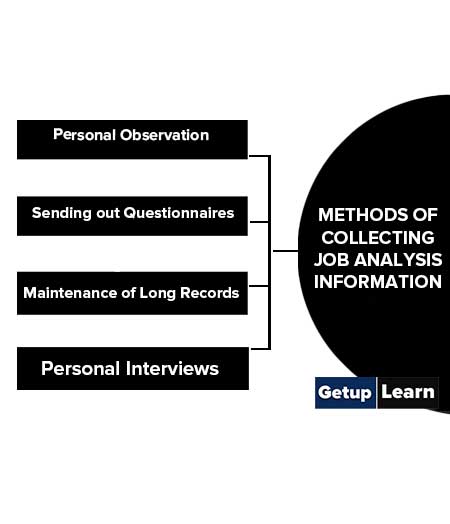
Personal Observation
The materials and equipment used, the working conditions and probable hazards, and an understanding of what the work involves are the facts that should be known by an analyst.
Sending out Questionnaires
This method is usually employed by engineering consultants. Properly drafted questionnaires are sent out to job-holders for completion and are returned to supervisors. However, the information received is often unorganized and incoherent. The idea of issuing a questionnaire is to elicit the necessary information from job-holders so that any error may first be discussed with the employee and, after due corrections, may be submitted to the job analyst.
Maintenance of Long Records
The employee maintains a daily record of duties he performs, marking the time at which each task is started and finished. But this system is incomplete, for it does not give us any desirable data on supervisor relationships, the equipment used, and working conditions. Moreover, it is time-consuming.
Personal Interviews
Personal Interviews may be held by the analyst with the employees, and answers to relevant questions may be recorded. But the method is time-consuming and costly.
Purpose of Job Analysis
A comprehensive job analysis program is an essential ingredient of sound personnel management. It is fundamental to manpower management programs because the results of job analysis are widely used throughout the programs. The information provided by job analysis is useful, if not essential, in almost every phase of employee relations.
- Organization and Manpower Planning
- Recruitment and Selection
- Wage and Salary Administration
- Job Re-engineering
- Employee Training and Management Development
- Performance Appraisal
- Health and Safety

Organization and Manpower Planning
It is helpful in organizational planning for it defines labor needs in concrete terms and coordinates the activities of the workforce, and clearly divides duties and responsibilities.
Recruitment and Selection
By indicating the specific requirements of each job (i.e., the knowledge and skills), it provides a realistic basis for hiring, training, placement, transfer, and promotion of personnel.
Wage and Salary Administration
By indicating the qualifications required for doing specified jobs and the risks and hazards involved in its performance, it helps in salary and wage administration. Job analysis is used as a foundation for job evaluation.
Job Re-engineering
Job analysis provides information that enables us to change jobs in order to permit they’re being manned by personnel with specific characteristics and qualifications. This takes two forms:
- Industrial Engineering Activity, which is concerned with the operational analysis, motion study, work simplification methods, and improvements in the place of work and its measurement, and aims at improving efficiency, reducing unit labor costs, and establishing the production standard which the employee is expected to meet.
- Human Engineering Activity, takes into consideration human capabilities, both physical and psychological, and prepares the ground for complex operations of industrial administration, increased efficiency and better productivity.
Employee Training and Management Development
Job analysis provides the necessary information for the management of training and development programs. It helps it to determine the content and subject matter of in-training courses. It also helps in checking application information, interviewing, weighing test results, and checking references.
Performance Appraisal
Performance appraisal helps in establishing clear-cut standards which may be compared with the actual contribution of each individual.
Health and Safety
Health and safety provide an opportunity for identifying hazardous conditions and unhealthy environmental factors so that corrective measures may be taken to minimize and avoid the possibility of accidents.
What are the uses of job analysis information?
Uses of Job Analysis Information:
1. Human Resource Planning
2. Job Evaluation
3. Recruitment, Selection, and Placement
4. Optimum Use of Human Resource
5. Training and Development
6. Labour Management Relations
7. Job Design
8. Safety and Welfare Measures
9. Compensation
10. Reduce Frustration
11. Determines Authority Responsibility Relationship.
Which of the methods of collecting job analysis information is most effective and why?
These are the four methods of collecting job analysis information given below:
1. Personal Observation
2. Sending out Questionnaires
3. Maintenance of Long Records
4 Personal Interviews.
What are the 4 purposes of job analysis?
Following are the 4 purposes of job analysis:
1. Organization and Manpower Planning
2. Recruitment and Selection
3. Wage and Salary Administration
4. Job Re-engineering
5. Employee Training and Management Development
6. Performance Appraisal
7 Health and Safety.


